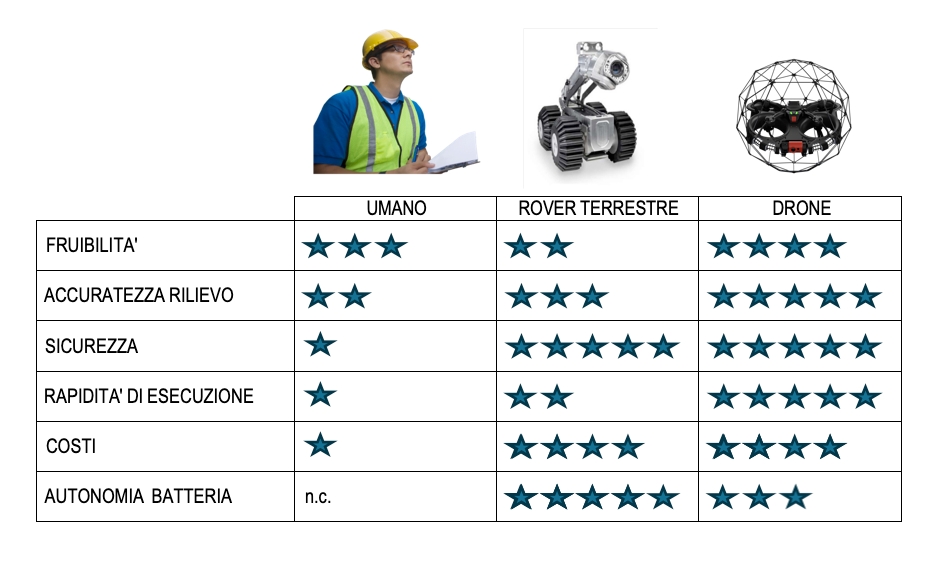We compared the main tools used, highlighting the merits and demerits of the different solutions that can be adopted.
Confined environment video inspection is a visual investigation of the condition of pipelines, pipes, tanks, silos, boilers...and any environment, civil or industrial, that needs a health and maintenance check. Nowadays we have at our disposal different technological solutions that facilitate the activity by reducing costs, risks and intervention time. We have tried to highlight the main differences that emerge in the use of Drones or Terrestrial Rovers compared to the use of human resources.

Usability
Drones offer limitless mobility, overcoming horizontal and vertical obstacles, easily inspecting upper and lower parts of vertical structures or pipelines. Unlike terrestrial rovers, which are limited in their movements by the maximum length of their power cable (usually no more than 300 m) and any obstacles in the path. The use of human resources often involves the adoption of safety infrastructure in order to move freely.
Survey Accuracy
Technological developments in recent years, geared mainly toward drones, allow them to offer the best in terms of effectiveness and performance. With state-of-the-art sensors and advanced imaging capabilities, they provide detailed and accurate visualization of the inspected environment. The arrangement of sensors on some rovers does not allow a 360-degree view, effectively limiting the ability to detect important details during inspection.
Safety
In terms of safety, drones and rovers offer the highest guarantees as they do not require the use of people within hazardous environments. Any limitations in their use are to be recorded in high-explosive environments, such as oil and gas.
Speed of execution
Nimble navigation in confined environments is a strength of drones that speeds up intervention time. The operator is able to quickly locate and reach the area to be inspected, and with video footage and real-time projection on the pilot's monitor, immediate confrontation with a Client supervisor is possible.
Costs
The almost complete elimination of any security infrastructure and the total elimination of risk makes the solution by technological device incredibly cost-effective compared to traditional inspection.
Operating autonomy - Battery life
Given its small size, the drone offers less space dedicated to the battery than the rover, so its operating range is less. Many rovers are powered via cables that connect the vehicle to an external power source. While power is an asset, these cables can be a constraint to mobility, especially in confined environments where the cable can snag or hinder navigation.
Bureaucratic-permitting process.
The high safety standard of technological devices and the possibility for the operator to rule away from the risk area significantly reduce the bureaucratic and permitting process for performing the inspection. In addition, the ability to operate in the absence of safety infrastructure (ladders, scaffolding, anchors) facilitates the speed of intervention.
Conclusions
The use of technological solutions compared to the use of direct operators offers a significant increase in safety with reduced costs and intervention time. It also ensures the possibility of intervention in all conditions. In a particular way, the drone allows intervention without particular problems, in environments with total absence of light, even very dusty and with the presence of obstacles. These solutions guarantee a large volume of real-time data (Videos, maps, images) useful to be reworked in post production. A historical, chronological archive of inspections facilitates control and maintenance activities.
Want to find out more about the Drone Video Inspection solution? Contact our customer service department. One of our Field Engineers will be happy to assist you and schedule a dedicated demo.